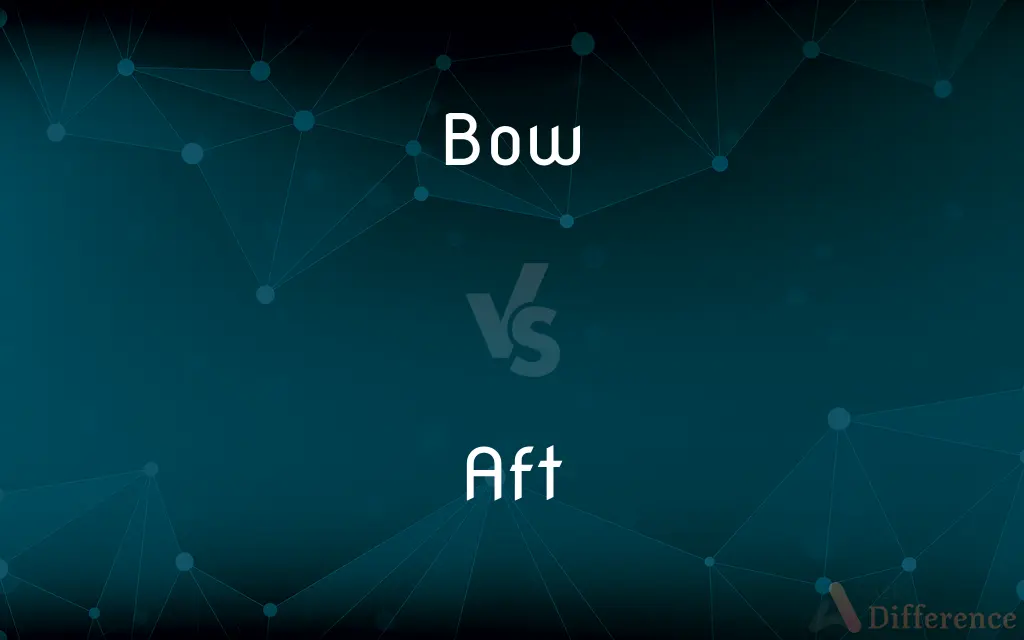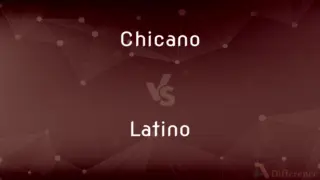Bow vs. Aft — What's the Difference?
By Fiza Rafique & Maham Liaqat — Updated on April 2, 2024
The bow refers to the front end of a ship or boat, facing forward during movement, and is associated with cutting through water. The aft, on the other hand, is the rear or back part, crucial for steering and propulsion.

Difference Between Bow and Aft
Table of Contents
ADVERTISEMENT
Key Differences
The bow of a vessel is its forward-most part, designed to minimize water resistance and aid in smooth navigation. It is the first to meet waves and is often shaped to cut through water efficiently, reducing drag and impact from the sea. Whereas the aft is located at the rear end of the vessel and plays a pivotal role in the direction and propulsion. It houses the ship's propellers or rudders, which are essential for steering and moving the vessel forward.
When considering visibility and orientation, the bow offers a forward-looking perspective, which is crucial for navigation and avoiding obstacles in the water. Crew members and navigation equipment positioned near the bow are tasked with lookout and piloting responsibilities. On the other hand, the aft provides a vantage point for observing and managing the vessel's wake and ensuring that the ship is following its intended path correctly.
In terms of functionality, the bow often contains equipment or features designed for mooring, anchoring, or even launching smaller boats or equipment. It's where you might find anchors stored or deployed. The aft, however, is typically where the engine room is located, especially in larger vessels, and it's from here that the ship's propulsion and power systems are controlled.
During docking and mooring operations, the bow's role is to approach the dock or mooring site first, allowing crew members to secure the vessel. The aft, meanwhile, is crucial for maneuvering the ship into position, especially when reversing into a dock or adjusting the ship's orientation.
Safety procedures and evacuation plans also differentiate between the bow and aft. For instance, lifeboats and emergency equipment might be strategically placed at both ends of the ship, but the procedures for evacuation can differ based on the location of an emergency, with specific routes and assembly points designated at the bow and aft.
ADVERTISEMENT
Comparison Chart
Location
Front end of a ship or boat
Rear end of a ship or boat
Primary Function
Cutting through water, reducing resistance
Steering and propulsion
Navigation
Forward-looking perspective, lookout
Observing vessel's wake, ensuring correct path
Equipment/Features
Anchors, equipment for mooring
Propellers, rudders, engine room
Docking/Mooring
Approaches dock or mooring site first
Crucial for maneuvering, especially reversing
Compare with Definitions
Bow
The forward part of a ship or boat.
The captain stood at the bow, watching the horizon.
Aft
The rear part of a ship or boat.
The passengers gathered at the aft to watch the sunset.
Bow
Often features a distinctive shape for efficiency.
The streamlined bow of the racing boat reduced drag.
Aft
Houses the ship's steering mechanisms.
The aft is equipped with powerful rudders for navigation.
Bow
Location for mooring and anchoring equipment.
The crew prepared the anchor at the bow for docking.
Aft
Location of the engine room in larger vessels.
The engineers worked in the aft to maintain the engines.
Bow
Designed to minimize water resistance.
The ship's bow cuts through the waves efficiently.
Aft
Provides a view of the ship's wake.
From the aft, you can see the trail left by the ship.
Bow
Forward-looking perspective for navigation.
The lookout at the bow spotted a distant ship.
Aft
Crucial for maneuvering and propulsion.
The aft thrusters were engaged to reverse into the dock.
Bow
A knot tied with two loops and two loose ends, used especially for tying shoelaces and decorative ribbons
A girl with long hair tied back in a bow
Aft
"Aft", in nautical terminology, is an adjective or adverb meaning 'towards the stern (rear) of the ship', when the frame of reference is within the ship, headed at the fore. For example, "Able Seaman Smith; lie aft!" or "What's happening aft?".
Bow
A weapon for shooting arrows, typically made of a curved piece of wood joined at both ends by a taut string.
Aft
At, in, toward, or close to the stern of a vessel or the rear of an aircraft or spacecraft.
Bow
A long, partially curved rod with horsehair stretched along its length, used for playing the violin and other stringed instruments.
Aft
(nautical) The stern portion of a vessel.
Bow
A curved stroke forming part of a letter (e.g. b, p).
Aft
: the time of day from noon until early evening.
Bow
A metal ring forming the handle of a key or pair of scissors.
Aft
(nautical) At, near, or towards the stern of a vessel (with the frame of reference within the vessel).
Bow
An act of bending the head or upper body as a sign of respect or greeting
The man gave a little bow
Aft
Located at the back of a boat, ship, or airplane
Bow
The front end of a ship
Water sprayed high over her bows
Aft
Near or towards the stern of a vessel; astern; abaft.
Bow
Play (a stringed instrument or music) using a bow
The techniques by which the pieces were bowed
Aft
(nautical, aeronautical) situated at or toward the stern or tail
Bow
Bend the head or upper part of the body as a sign of respect, greeting, or shame
He turned and bowed to his father
She knelt and bowed her head
Councillors stood with heads bowed
Aft
At or near or toward the stern of a ship or tail of an airplane;
Stow the luggage aft
Ships with square sails sail fairly efficiently with the wind abaft
The captain looked astern to see what the fuss was about
Bow
Bend with age or under pressure
The creepers were bowed down with flowers
The roof trusses bowed as the wind fought to rip the roof free
Bow
(of a new film or product) be premiered or launched
The trailer bowed in theaters nationwide on December 23
The Pentium III bowed in early 1999
Bow
The front section of a ship or boat.
Bow
Either of the sides of this front section
The starboard bow.
Bow
The oar or the person wielding the oar closest to the bow in a racing shell.
Bow
An inclination of the head or body, as in greeting, consent, courtesy, acknowledgment, submission, or veneration.
Bow
A bent, curved, or arched object.
Bow
A weapon consisting of a curved, flexible strip of material, especially wood, strung taut from end to end and used to launch arrows.
Bow
An archer.
Bow
Archers considered as a group.
Bow
(Music) A rod having horsehair drawn tightly between its two raised ends, used in playing instruments of the violin and viol families.
Bow
A stroke made by this rod.
Bow
A knot usually having two loops and two ends; a bowknot.
Bow
A frame for the lenses of a pair of eyeglasses.
Bow
The part of such a frame passing over the ear.
Bow
A rainbow.
Bow
An oxbow.
Bow
To bend or curve downward; stoop.
Bow
To incline the body or head or bend the knee in greeting, consent, courtesy, acknowledgment, submission, or veneration.
Bow
To yield in defeat or out of courtesy; submit.
Bow
To bend (the head, knee, or body) to express greeting, consent, courtesy, acknowledgment, submission, or veneration.
Bow
To convey (greeting, for example) by bending the body.
Bow
To escort deferentially
Bowed us into the restaurant.
Bow
To cause to acquiesce; submit.
Bow
To overburden
Grief bowed them down.
Bow
To bend (something) into the shape of a bow.
Bow
(Music) To play (a stringed instrument) with a bow.
Bow
To bend into a curve or bow.
Bow
(Music) To play a stringed instrument with a bow.
Bow
A weapon made of a curved piece of wood or other flexible material whose ends are connected by a string, used for shooting arrows.
Bow
A curved bend in a rod or planar surface, or in a linear formation such as a river (see oxbow).
Bow
A rod with horsehair (or an artificial substitute) stretched between the ends, used for playing various stringed musical instruments.
Bow
A stringed instrument (chordophone), consisting of a stick with a single taut cord stretched between the ends, most often played by plucking.
Bow
A type of knot with two loops, used to tie together two cords such as shoelaces or apron strings, and frequently used as decoration, such as in gift-wrapping.
Bow
Anything bent or curved, such as a rainbow.
Bow
The U-shaped piece which goes around the neck of an ox and fastens it to the yoke.
Bow
Either of the arms of a pair of spectacles, running from the side of the lens to behind the wearer's ear.
Bow
Any instrument consisting of an elastic rod, with ends connected by a string, employed for giving reciprocating motion to a drill, or for preparing and arranging hair, fur, etc., used by hatters.
Bow
(nautical) A crude sort of quadrant formerly used for taking the sun's altitude at sea.
Bow
(saddlery) Two pieces of wood which form the arched forward part of a saddletree.
Bow
The part of a key that is not inserted into the lock and that is used to turn the key.
Bow
A gesture, usually showing respect, made by inclining the head or bending forward at the waist; a reverence
He made a polite bow as he entered the room.
Bow
(nautical) The front of a boat or ship.
Bow
(rowing) The rower that sits in the seat closest to the bow of the boat.
Bow
Obsolete spelling of bough
Bow
C|en|Foods}} {{alternative form of bao; any of several Chinese buns and breads
Bow
To play music on (a stringed) instrument using a bow.
The musician bowed his violin expertly.
Bow
(intransitive) To become bent or curved.
The shelf bowed under the weight of the books.
Bow
(transitive) To make something bend or curve.
Bow
To exercise powerful or controlling influence over; to bend, figuratively; to turn; to incline.
Bow
(intransitive) To bend oneself as a gesture of respect or deference.
That singer always bows towards her audience for some reason.
Bow
To debut.
Bow
(intransitive) To defer (to something).
I bow to your better judgement in the matter.
Bow
(transitive) To give a direction, indication, or command to by bowing.
Bow
To cause to deviate from straightness; to bend; to inflect; to make crooked or curved.
We bow things the contrary way, to make them come to their natural straightness.
The whole nation bowed their necks to the worst kind of tyranny.
Bow
To exercise powerful or controlling influence over; to bend, figuratively; to turn; to incline.
Adversities do more bow men's minds to religion.
Not to bow and bias their opinions.
Bow
To bend or incline, as the head or body, in token of respect, gratitude, assent, homage, or condescension.
They came to meet him, and bowed themselves to the ground before him.
Bow
To cause to bend down; to prostrate; to depress,; to crush; to subdue.
Whose heavy hand hath bowed you to the grave.
Bow
To express by bowing; as, to bow one's thanks.
Bow
To bend; to curve.
Bow
To stop.
They stoop, they bow down together.
Bow
To bend the head, knee, or body, in token of reverence or submission; - often with down.
O come, let us worship and bow down: let us kneel before the Lord our maker.
Bow
To incline the head in token of salutation, civility, or assent; to make bow.
Admired, adored by all circling crowd,For wheresoe'er she turned her face, they bowed.
Bow
To play (music) with a bow.
Bow
An inclination of the head, or a bending of the body, in token of reverence, respect, civility, or submission; an obeisance; as, a bow of deep humility.
Bow
Anything bent, or in the form of a curve, as the rainbow.
I do set my bow in the cloud.
Bow
A weapon made of a strip of wood, or other elastic material, with a cord connecting the two ends, by means of which an arrow is propelled.
Bow
An ornamental knot, with projecting loops, formed by doubling a ribbon or string.
Bow
The U-shaped piece which embraces the neck of an ox and fastens it to the yoke.
Bow
An appliance consisting of an elastic rod, with a number of horse hairs stretched from end to end of it, used in playing on a stringed instrument.
Bow
An arcograph.
Bow
Any instrument consisting of an elastic rod, with ends connected by a string, employed for giving reciprocating motion to a drill, or for preparing and arranging the hair, fur, etc., used by hatters.
Bow
A rude sort of quadrant formerly used for taking the sun's altitude at sea.
Bow
Two pieces of wood which form the arched forward part of a saddletree.
Bow
The bending or rounded part of a ship forward; the stream or prow.
Bow
One who rows in the forward part of a boat; the bow oar.
Bow
A knot with two loops and loose ends; used to tie shoelaces
Bow
A slightly curved piece of resilient wood with taut horsehair strands, used in playing certain stringed instrument
Bow
Front part of a vessel or aircraft;
He pointed the bow of the boat toward the finish line
Bow
Curved piece of resilient wood with taut cord to propel arrows
Bow
Something curved in shape
Bow
Bending the head or body or knee as a sign of reverence or submission or shame
Bow
An appearance by actors or performers at the end of the concert or play in order to acknowledge the applause of the audience
Bow
A decorative interlacing of ribbons
Bow
A stroke with a curved piece of wood with taut horsehair strands that is used in playing stringed instruments
Bow
Bend one's knee or body, or lower one's head;
He bowed before the King
She bowed her head in shame
Bow
Submit or yield to another's wish or opinion;
The government bowed to the military pressure
Bow
Bend the head or the upper part of the body in a gesture of respect or greeting;
He bowed before the King
Bow
Bend one's back forward from the waist on down;
He crouched down
She bowed before the Queen
The young man stooped to pick up the girl's purse
Bow
Play on a string instrument
Common Curiosities
How do the bow and aft affect a ship's stability?
The design of both the bow and aft contributes to a ship's hydrodynamics and stability in water, affecting how it moves and responds to waves.
Why is the aft important for a ship's movement?
The aft houses the propulsion and steering mechanisms, making it essential for controlling the ship's direction and speed.
Can the terms bow and aft be used for any vessel?
Yes, these terms apply to all types of watercraft, from small boats to large ships.
Is there a difference in the materials used for the bow and aft?
Generally, the materials are consistent throughout the vessel, but the construction and reinforcements might differ due to the different functions of the bow and aft.
How does the design of the aft contribute to fuel efficiency?
The design of the aft, including the placement of propellers and rudders, can significantly affect water flow and resistance, impacting fuel efficiency.
What role does the bow play in emergency situations?
The bow can serve as a critical point for evacuation or rescue operations, often equipped with lifeboats and emergency equipment.
What determines the bow of a ship?
The bow is determined by the ship's design to be the forward-most part, optimized for navigating through water.
How do modern ships enhance the functionality of the bow and aft?
Modern ships incorporate advanced technology and design features to enhance efficiency, such as bulbous bows and optimized rudder and propeller systems.
How do wind and water currents affect the bow and aft differently?
The bow is designed to face wind and currents directly, minimizing impact, while the aft's design ensures that the vessel remains stable and steerable.
Can the bow and aft of a ship be modified?
Modifications are possible but must comply with safety and design standards to ensure the vessel's integrity and performance.
How do bow thrusters assist in maneuvering?
Bow thrusters provide lateral movement, aiding in docking and navigating tight spaces without affecting the main propulsion at the aft.
Are there specific safety regulations for the bow and aft?
Yes, there are maritime safety regulations that specify requirements for both the bow and aft, including navigation lights and emergency procedures.
What is the significance of the bow shape in icebreaker ships?
Icebreaker ships have specially designed bows to break through ice, using a combination of weight, shape, and power to clear paths.
How is the space at the bow and aft utilized on cruise ships?
On cruise ships, the bow often features observation decks, while the aft may host amenities like pools or dining areas, optimizing the use of space for passenger enjoyment.
What historical changes have influenced the design of the bow and aft?
Technological advances and changes in maritime needs have led to evolving designs, focusing on efficiency, speed, and safety.
Share Your Discovery

Previous Comparison
Chicano vs. Latino
Next Comparison
Urbanisation vs. UrbanizationAuthor Spotlight
Written by
Fiza RafiqueFiza Rafique is a skilled content writer at AskDifference.com, where she meticulously refines and enhances written pieces. Drawing from her vast editorial expertise, Fiza ensures clarity, accuracy, and precision in every article. Passionate about language, she continually seeks to elevate the quality of content for readers worldwide.
Co-written by
Maham Liaqat















































